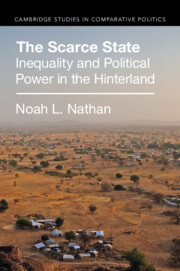Book contents
- Frontmatter
- Contents
- Figures
- Maps
- Tables
- Acknowledgments
- Part I: Introduction
- 1 The Politics of State Scarcity
- 2 The Large Effects of Scarce States
- 3 Northern Ghana’s Scarce State
- Part II: Societal Effects
- 4 The Origins of Inequality
- 5 Bottom-Up Responses to Scarcity
- Part III: Political Effects
- 6 Dynasties
- 7 Invented Chiefs and Distributive Politics
- 8 Nonstate Violence as a State Effect
- Part IV: Extending the Argument
- 9 Shadow Cases
- 10 The Paradox of State Weakness
- Appendix: Qualitative Interviews
- References
- Index
- Other Books in the Series
6 - Dynasties
Published online by Cambridge University Press: 23 February 2023
- Frontmatter
- Contents
- Figures
- Maps
- Tables
- Acknowledgments
- Part I: Introduction
- 1 The Politics of State Scarcity
- 2 The Large Effects of Scarce States
- 3 Northern Ghana’s Scarce State
- Part II: Societal Effects
- 4 The Origins of Inequality
- 5 Bottom-Up Responses to Scarcity
- Part III: Political Effects
- 6 Dynasties
- 7 Invented Chiefs and Distributive Politics
- 8 Nonstate Violence as a State Effect
- Part IV: Extending the Argument
- 9 Shadow Cases
- 10 The Paradox of State Weakness
- Appendix: Qualitative Interviews
- References
- Index
- Other Books in the Series
Summary
Dynastic families in Northern Ghana are widespread, extending decades prior to democratic rule into the colonial era, or earlier. These dynasties connect initial colonial-era chiefs – often installed into their positions directly by the state – to modern elected officeholders. I link Northern Ghana’s dynasties to the first two state interventions described in Chapter 3: the colonial invention of chieftaincy and differential access to education for chiefs’ families.
- Type
- Chapter
- Information
- The Scarce StateInequality and Political Power in the Hinterland, pp. 169 - 201Publisher: Cambridge University PressPrint publication year: 2023

